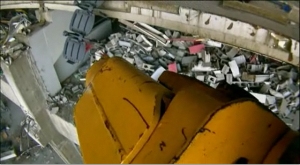Shooting a 3D documentary: demolition POV – ContourHD versus GoPro HD
3D POV, here we come. We’ve started looking into cameras to shoot POV footage for our first 3D documentary.
This content is a must – there’s nothing like being able to put a camera where no human dare go and capture the scene from that angle.
For example, what’s it like to ride on an excavator boom while it’s ripping bleachers apart?
An excavator demolishing bleachers, the RCA Dome

This is a screen grab from the demolition of the RCA Dome in Indianapolis, Indiana, the subject of a previous Blowdown show – the explosive demolition series we’ll be filming in 3D.
Now imagine part of the grapple in negative space.
But it’s going to take a bit to get there.
The cameras we use have to be:
1) Lightweight enough to be mounted onto a Magic Arm, or duct taped/fastened to something on the machine.
2) Placed at an interaxial distance small enough to film an object within 1 ½ metres from the lens.
3) Workable with a customized side-by-side rig (that we’re apparently going to build … of course).
4) Capable of turning on in sync.
Our stereographer, Sean White, has narrowed it down to two contenders: the ContourHD 1080p or the GoPro HD.
Suspect the Contours will reign because they’re less boxy, but the GoPro’s a bit better quality – so I’d like to find a way to use if possible.
We’ll see how the “dare to compare” goes.

